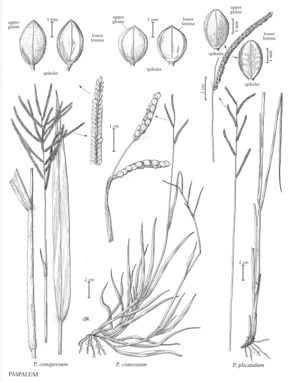Paspalum convexum
Plants annual. Culms 10-53 cm, erect; nodes glabrous. Sheaths pubescent or glabrous; ligules 2-4.1 mm; blades 5-25(80) cm long, 2.9-10.2(12) mm wide, flat. Panicles terminal, with 1-5 racemosely arranged branches; branches 1.1-5.4(7) cm, divergent; branch axes 0.8-1.3 mm wide, not or narrowly winged, glabrous, terminating in a spikelet. Spikelets 2.1-2.6 mm long, 1.7-2.4 mm wide, paired, appressed to the branch axes, broadly obovate to suborbicular, shortly pubescent, light to dark brown. Lower glumes absent; upper glumes and lower lemmas shortly pubescent, 5-7-veined, margins entire; lower paleas rarely present; upper florets dark glossy brown. Caryopses 1.3-1.5 mm, white. 2n = 30,32,40,60.
Distribution
Puerto Rico, Md., Tex., Miss., La.
Discussion
Paspalum convexum grows in disturbed areas in the southern United States. It is native from Mexico and the Caribbean Islands to Brazil. It is not considered to have particularly high forage value.
Selected References
None.
